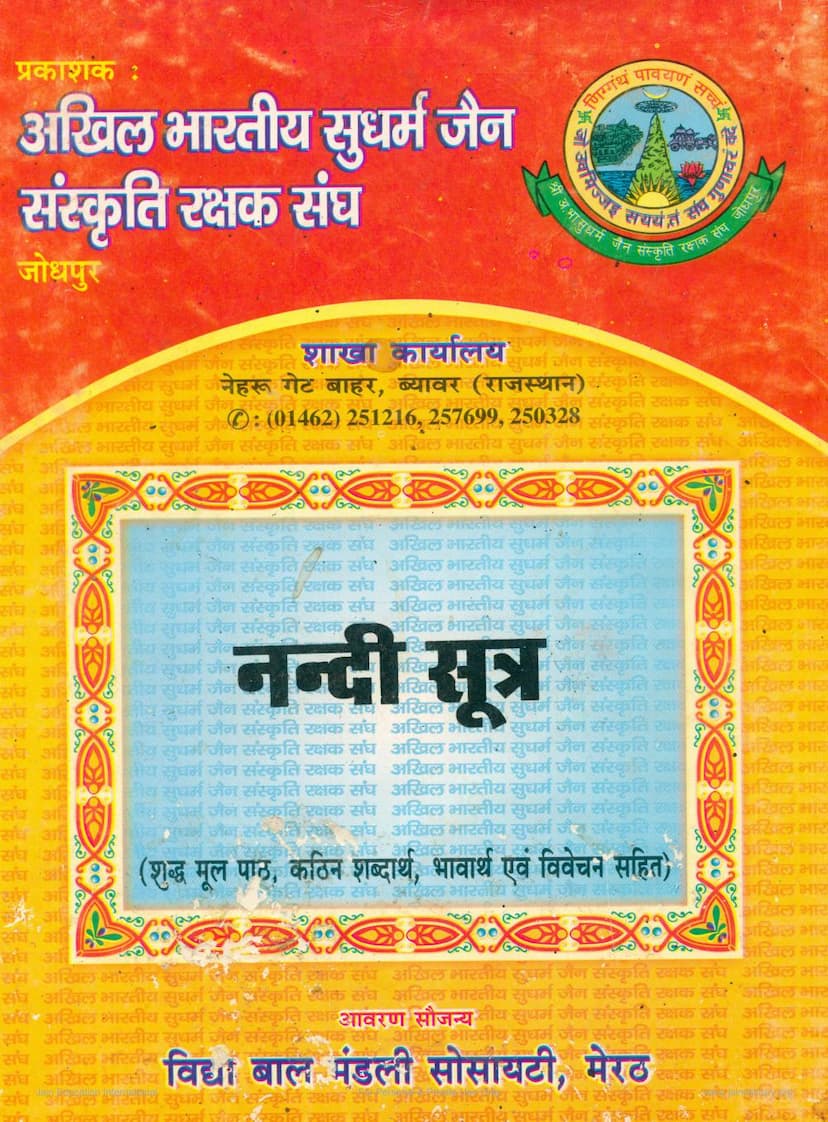Nandi Sutra
Added to library: September 2, 2025

Summary
Here's a comprehensive summary of the Nandi Sutra, based on the provided Jain text, presented in English:
The Nandi Sutra is a foundational text in Jainism, considered a "Moola Sutra" (core scripture). Its name itself, "Nandi," signifies joy, happiness, and delight. The sutra primarily expounds upon the "Five Types of Knowledge" (Pancha Jnana) in Jain philosophy, which are central to the path of liberation.
Key Themes and Content:
-
The Centrality of Knowledge: The Nandi Sutra is unique among Jain scriptures for its singular focus on knowledge, particularly the five types of knowledge. Unlike other sutras that might cover multiple subjects like conduct, character, or rituals, Nandi Sutra exclusively deals with knowledge, emphasizing its role as the first and foremost aspect of the path to moksha (liberation).
-
The Five Types of Knowledge (Pancha Jnana): The sutra meticulously explains each of these five types of knowledge:
- Mati Jnana (Srutaprakasha): This refers to the knowledge gained through the senses and the mind. It is the empirical and intellectual knowledge that forms the basis for further understanding.
- Shruta Jnana: This is the knowledge acquired through listening, reading, or studying the teachings of the Tirthankaras and the scriptures. It is derived knowledge.
- Avadhi Jnana: This is clairvoyant knowledge, the ability to perceive gross objects beyond the limitations of senses and mind, limited by time, space, and substance.
- Manahparyaya Jnana: This is the telepathic knowledge, the ability to know the thoughts and mental states of others. It is also limited by specific conditions.
- Kevala Jnana: This is the absolute, omniscience knowledge, which is infinite, omniscient, and knows all substances, qualities, and states of existence simultaneously. It is the highest form of knowledge, attained in liberation.
-
Purity of Knowledge: The sutra emphasizes that the knowledge itself is pure, but its classification into right (Samyak) and wrong (Mithya) knowledge depends on the perspective and conviction of the knower. A scripture considered 'Mithya Shruta' can become 'Samyak Shruta' in the hands of a right-believer, and vice versa.
-
The Importance of Shruta Dharma: Before delving into the five types of knowledge, the sutra highlights the significance of 'Shruta Dharma' (knowledge-based righteousness). It explains that true understanding of Dharma comes through listening and studying the teachings (Shruta). This knowledge is essential before embarking on spiritual practices (Charitra Dharma).
-
Classification of Knowledge: The sutra details various classifications of knowledge, including:
- Indriya: Knowledge gained through the senses.
- Anindriya: Knowledge gained without the help of senses, directly by the soul.
- Mati-Shruta: Both Mati and Shruta Jnana are considered 'paroksha' (indirect) knowledge.
- Avadhi, Manahparyaya, Kevala: These are considered 'pratyaksha' (direct) knowledge.
- Dravya: The substance of knowledge.
- Kshetr: The scope or area of knowledge.
- Kaal: The temporal aspect of knowledge.
- Bhav: The qualitative aspect of knowledge.
-
The Nature of a Worthy Disciple: The Nandi Sutra, through various illustrative stories and analogies (like the mudgashila stone, pots, sieve, swans, etc.), describes the characteristics of a worthy recipient of knowledge and those who are not. It emphasizes qualities like receptivity, the ability to retain knowledge, proper understanding, and the absence of ego or malice.
-
The Role of Understanding and Practice: The sutra stresses that mere knowledge is not enough; it must be accompanied by correct understanding (Bhavarth) and practice (Vivechan). The purpose of this edition is to provide the original text along with its meaning and commentary for deeper comprehension.
-
Praise for the Sangha and Tirthankaras: The Nandi Sutra begins with hymns of praise for the Tirthankaras, particularly Lord Mahavir, and extols the virtues of the Jain Sangha (community) using various metaphors like a city, chariot, wheel, lotus, moon, sun, ocean, and Mount Meru.
-
The Succession of Acharyas: The sutra also includes an "Avalika" (genealogy or lineage) of the respected Acharyas who preserved and transmitted the Jain teachings through generations, including the compiler of the Nandi Sutra, Acharya Devavachak.
-
Appendices (Anugannandi and Laghu Nandi): The edition also includes "Anugannandi" and "Laghu Nandi" as appendices.
- Anugannandi: Expounds on the term "Anugya" (permission/sanction) in terms of its name, establishment, substance, space, time, and states.
- Laghu Nandi: Focuses solely on Shruta Jnana, as it is the knowledge gained through learning and practice.
Significance:
The Nandi Sutra is highly revered in Jainism for its comprehensive exposition on the nature and types of knowledge. Its study is believed to purify the mind and lead the practitioner towards higher spiritual states. It serves as a guide for understanding the various faculties of knowing available to a soul, ultimately paving the way for the attainment of Kevala Jnana. The emphasis on the methodical and gradual acquisition of knowledge highlights the Jain emphasis on right belief, right knowledge, and right conduct as the path to liberation.